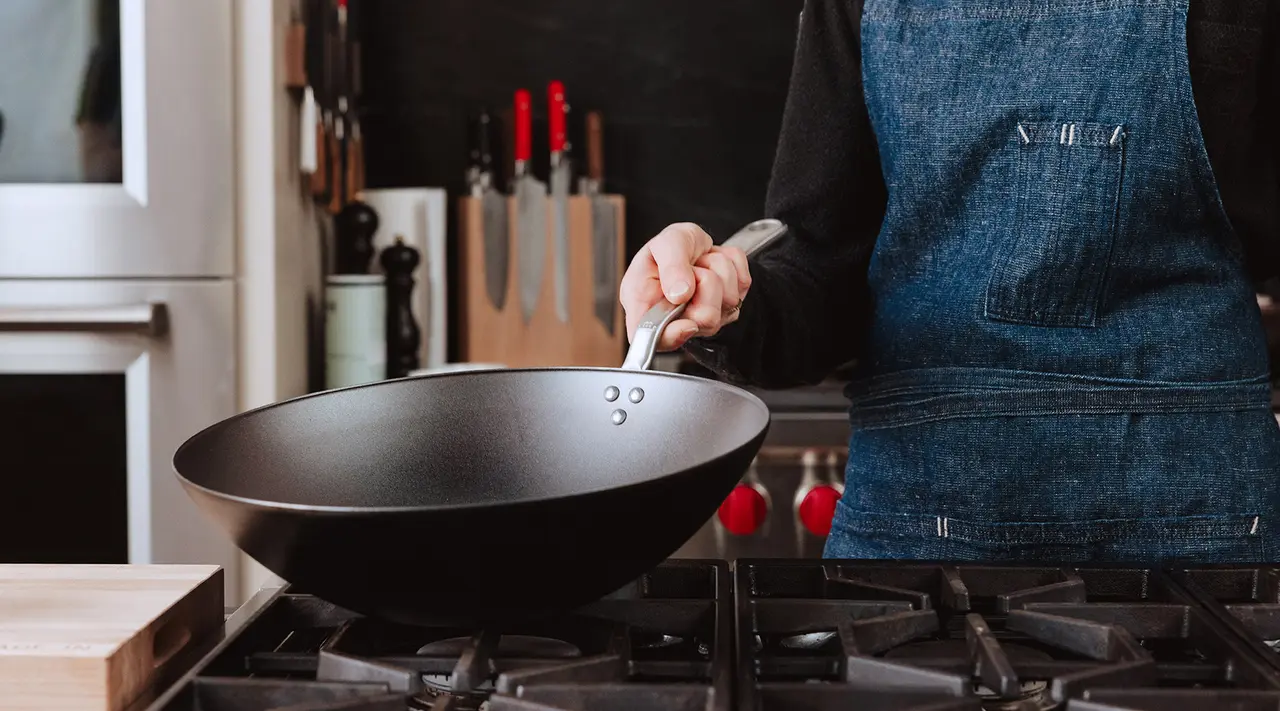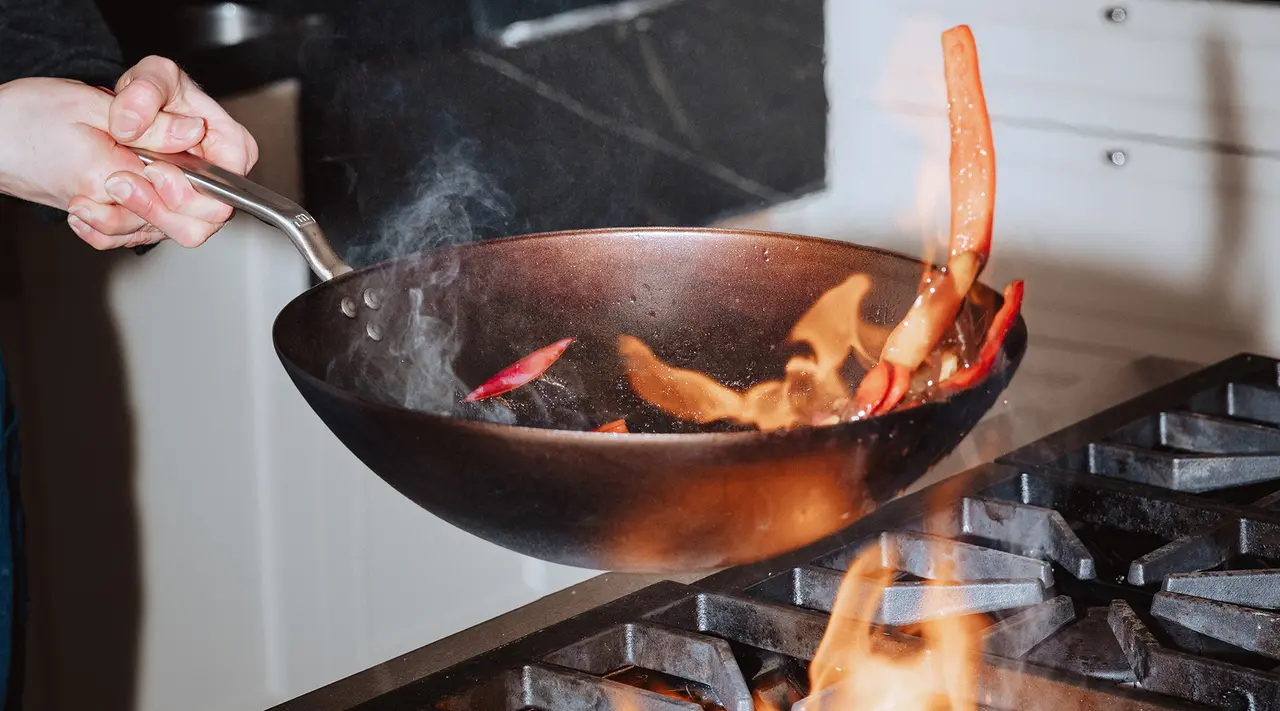The wok is a quintessential piece of Chinese cookware. With their high-walled, conical shape and ample surface area, woks are particularly suited to rapid, high-heat cooking methods like stir frying, which helps create the addictively smoky flavors and crisp textures of some of your favorite dishes.
Yet stir-frying is just the tip of the iceberg; a shockingly versatile tool, the wok is fantastic for everything from braising and steaming to boiling and deep frying. And to celebrate our newly redesigned Seasoned Carbon Steel Wok we’re here with an all-encompassing guide to buying, cooking with, and caring for these multi-purpose pans. Let’s dive in.
How to Prep Your Wok for Cooking

Once your wok is out of the box, here’s what you need to know before it makes its way to the stovetop.
Seasoning a New Wok
Assuming your wok is made of carbon steel, it’ll need to be seasoned prior to the first use (unless it’s pre-seasoned, like ours). Luckily, that process is no different from seasoning other carbon steel pans.
First, make sure you have the right materials: for both the stovetop and oven methods, you’ll need some Carbon Steel Seasoning Wax or other neutral-flavored, high smoke point oil, as well as a paper or dish towel. For the oven method, you’ll also need a sheet pan lined with aluminum foil.
Stovetop method:
1. Add a tiny (tiny!) amount of oil or seasoning wax to your wok, then use your paper or dish towel to spread it in even layer all around the inside. Make sure not to add too much; otherwise, you may end up with a sticky, uneven coating.
2. Place the pan over the burner, then turn the flame up to medium-high. After a few minutes, turn the heat up to high, then rotate the pan every minute or so to make sure it’s evenly heated.
3. While the pan is heating, check to see if there is any oil beading up on the pan’s surface; this usually means you’ve added too much. Wipe away any extra oil using your towel or dish cloth.
4. Once your pan begins to smoke, leave it to sit on the burner for a few minutes to help build up the seasoning, then turn off the stove and allow your pan to cool completely before using.
Oven method (AKA, our preferred seasoning method for carbon steel):
1. Place foil-lined sheet pan on the bottom rack of your oven; this is to catch any excess oil drips.
2. Preheat your oven to the same temperature as your seasoning oil’s smoke point: for grapeseed or our Carbon Steel Seasoning Wax, this is 450F.
3. Place your clean, dry wok on the stove over a low flame. Add a tiny amount of oil or seasoning wax, then rub it evenly all over the inside of the wok.
4. Remove pan from heat and place it upside down in your preheated oven, positioned above the baking sheet.
5. After an hour, turn off the oven. Allow your pan to cool completely before cooking.
Essential Wok Cooking Techniques

Now it’s time to get cooking. You’ll need a high-heat oil to get started: the best oils for stir frying, deep frying, and other high heat cooking methods are ones with a high smoke point, as well as a neutral flavor. Some of our favorites include peanut, canola, and avocado oils.
Stir-Frying
- Have your mise en place ready before you start cooking; since the whole process takes just a couple of minutes over very high heat, you’ll want all your ingredients ready at hand.
- Prevent overcrowding by stir-frying food in batches, starting with your protein and then setting it aside before adding vegetables, then aromatics, then sauces and rice, noodles, or other starches.
- To approximate the coveted flavor of wok hei (aka “breath of wok”), make sure to turn the heat up to high, use a well-seasoned carbon steel wok, and always use proper stir-frying technique.
- A wok spatula—a long, slightly angled spoon-spatula hybrid—is extremely useful for tossing, flipping, and moving food while stir frying. A regular spatula or tongs will do in a pinch.
Deep-Frying
- Always bring oil up to temperature before adding food to the wok; a deep fry thermometer should read at a consistent 375F.
- Cooking food in batches prevents oil temperature from dropping, and ensures properly cooked food.
- The wok’s sloped sides make it better suited to frying small pieces of food (e.g. french fries and calamari) than large ones. Read our guide to deep frying in a wok for step-by-steps.
Steaming
- Use a bamboo steamer nestled inside the wok itself to steam perfect dumplings, crisp-tender vegetables, and more.
- When steaming, keep an eye on the water level; allowing water to evaporate completely can cause your pan to scorch.
Smoking
- Use your wok to smoke food indoors by setting a sheet pan rack over the mouth of the wok, then placing food on top before turning up the flame to medium high.
- Make sure to use plenty of tin foil, both to line the inside of your wok and to seal everything up when you’re ready to smoke.
Braising & Boiling
- Preserve the texture and color of fresh vegetables by blanching them in a wok filled with boiling water, then submerging in a bowl of cold water.
- Take advantage of your wok’s high sides and ample volume with a technique called wok braising (technically, closer to simmering), which is used to create flavorful, saucy dishes like mapo tofu and beef and broccoli.
Common Mistakes to Avoid When Cooking With a Wok

Like any new pan, cooking with a wok takes a bit of a learning curve. Here’s what to avoid so you learn from our mistakes.
Overcrowding
Wok cooking is all about quick, even heat circulation and air flow, both of which are compromised when you overcrowd the pan with too much food at once. Make sure to cook food in batches, ensuring that your proteins and veggies are seared instead of steamed.
Using the Wrong Oil
Save the sesame oil for finishing your dish. While perfectly fine for medium- or low-heat cooking, certain oils—like unrefined sesame or extra virgin olive—have a relatively low smoke point, which means they’ll start to burn as your wok preheats. This can lead to a smoky kitchen and food that tastes like, well, burnt oil.
Not Following Preheating Guidelines
As we went over in detail up top, you should always be preheating your wok prior to adding food. This is important to preventing sticking, and can also help your food cook more evenly.
Cleaning Improperly
Harsh scrubbing, caustic cleaning supplies, and dishwashers can all have an adverse effect on your carbon steel wok’s seasoning. Here’s how to keep your wok clean, and your seasoning unscathed.
How to Choose the Right Wok
Woks come in two basic shapes: round-bottomed and flat-bottomed. Round-bottomed woks are typically found in Chinese restaurant kitchens, which are often custom-fitted with specialty wok burners that hold the wok in place. Flat-bottomed woks, on the other hand, are designed to sit flush against the flat surface of a Western-style kitchen stove, making them a more universal choice.
Now let’s talk material. The best woks, in our opinion, are made of carbon steel: durable, lightweight, and designed to handle extremely high temperatures, carbon steel is your best bet for approximating the wok’s signature smoky, savory char—aka wok hei—in your home kitchen. While cast iron is an acceptable alternative, it’s much heavier than carbon steel, making it harder to wield. We recommend against coated non stick woks, which will have a much lower maximum temperature than carbon steel, won’t give you as powerful of a sear, and will have a much shorter lifespan.
One of carbon steel’s other attributes is that it’s naturally non stick, so you can really crank the heat without worrying about a charred, sticky mess. Ideally, your carbon steel wok will also come pre-seasoned (ours does) and ready to use straight out of the box: if yours is not, we’ve got a handy guide to help get you started.
Ready to Cook?
While it might take a little bit of practice to nail the proper stir-fry technique, woks make for a versatile, powerful tool that proves to be a fantastic—and accessible—way to kick your weekly cooking regimen up a notch. Case in point, this chewy, smoky, garlicky Chow Fun with Flank Steak that lets you practice your wok hei skills.































